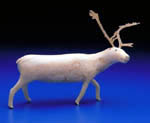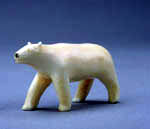"A few things in the way of curios"
Historic Ivories at the Canadian Museum of Civilization
Maria Von Finckenstein
Curator of Inuit Art
Canadian Ethnology Service
Canadian Museum of Civilization
This essay was originally published in Inuit Art Quarterly, vol.14, no.4 (Winter 1999), with revisions by the author in March 2001. Reproduced by permission.

Applied to Inuit art, the term "historic" serves to distinguish the period between roughly 1750 and 1948. It's the era between first sustained contact between Inuit and visitors to the North (which varied according to region) and the beginning of the commercial artform, which started in 1948 with James Houston's first trip to Inukjuak. The Canadian Museum of Civilization (CMC) owns approximately 360 carvings that stem from this period.
This body of work created over roughly two centuries has received scant attention from researchers. Jean Blodgett (1979) and Bernadette Driscoll (1988) have both written general overviews of the period, while Charles Martijn has quoted various explorers' comments about art making in different areas, without going into any detail about local or regional styles (Martijn, 1964). Jane Sproull Thompson, in her important article "A Tiny Arctic World", filled in the picture for the second half of the 19th century in Labrador, where there was a distinctive tradition of creating little ivory miniatures reflecting details of everyday camp life (Thomson, 1992).

I will try here to add another piece to the puzzle. The CMC owns a set of ivory carvings that were collected by A.P. Low and the surgeon L.E. Borden, both of whom participated in a government expedition on the Neptune in 1903-04. The purpose of the expedition was to survey the areas around Southampton Island and to establish a customs office at Port Burwell, where ships entering or leaving Hudson Bay were to report from then on. Previously, American and Scottish whalers had been hunting in Canadian waters without any impediment. The expedition constituted an important step towards establishing the Canadian claim to the Arctic.
During the expedition both Low and Borden collected ivory carvings. So far, those donated by A.P. Low (cat.# IV-B-768 - IV-B-818) have been dated to circa 1880-1890, under the assumption that they were collected by Low on one of his former expeditions to Labrador. I am convinced, however, they were collected during the Neptune expedition. They were transferred to the CMC in 1962 but no provenance was given at that time.

The Low family deposited this collection of carvings at the Public Archives in 1943. Unfortunately, no detailed listing exists in the Archives' records although there is one "list of material presented to the Public Archives by Miss Estelle Low" among the gift correspondence from 1943. The second item on this list laconically refers to "miscellaneous lot of carved articles and a beaded bag made by the Eskimos of Labrador." Obviously Miss Estelle Low, daughter of Albert P. Low, did not know any specifics about the provenance of the ivory carvings when she donated them to the Public Archives.

Borden, who died in 1963, made a bequest in his will of "all his Esquimo Walrus Carvings and all his diaries and notebooks concerning the Arctic region, for use in the Government of Canada Archives" (Davies, 1963). Again, no list survives to enlighten us as to where the pieces were collected.
In 1964, the Dominion Archivist, one Dr. Lamb, expressed his delight at uniting the two collections of carvings. He wrote to Borden's widow:

"I think I told Dr. Borden and yourself that the Low family gave to the Archives,
a good many years ago, the collection of carvings that Mr. Low had gathered in
the course of his famous expedition. These were transferred to the National
Museum a couple of years ago. They resemble and complement Dr. Borden's collection
in many ways, and I am very glad that the two have been brought together."
(Lamb, 1964; my italics)
The date of Borden's pieces is easy to establish. The Neptune cruise was the only expedition in which he ever participated, so there is no doubt that his collection dates from 1903-04. As Dr. Lamb correctly noticed, there is a great stylistic resemblance between the carvings from both collections. Hence it is fairly safe to assume that A.P. Low's ivory carvings also stem from 1903/04.